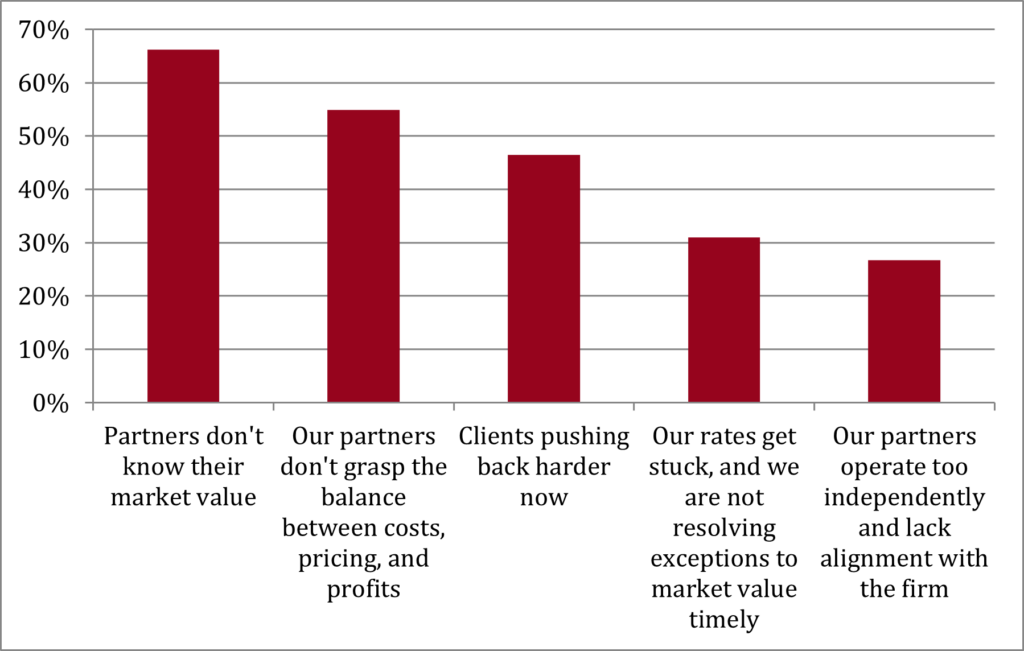2024 Strategic Pricing Flash Survey Insights on Knowing Your Value
I recently published our 2024 Strategic Pricing Survey findings, which uncovered significant insights into law firms’ successes and challenges in pricing strategies. The survey highlighted the continuation of solid rate trends into next year, the hurdles in rate management and pricing, the evolving design of pricing teams, and the growing intersection of AI and pricing. You can explore the full survey report HERE.
Challenges to Effective Pricing Survey Chart
For today’s blog, I would like to focus on a key finding from the survey related to the challenges associated with effective pricing. The responses to this question were particularly insightful, revealing important challenges, including:
- Partners’ limited understanding of market or fair value,
- The knowledge gap existing between pricing decisions and their impact on profitability,
- Marketplace pricing fatigue and increasing client resistance,
- Rate stagnation, particularly in returning discounts to standard rates and
- Siloed working patterns among lawyers impede pricing effectiveness.
A chart showing the percentages is illustrated below:

While law firms can address all five pricing barriers, only client pushback stems directly from external factors. The remaining barriers are often self-imposed, resulting from a lack of focus, unstructured processes, and pricing disconnect from the daily routine. By adopting systematic approaches, firms can overcome these internal challenges and achieve more effective pricing outcomes. Let’s begin by examining the client’s perspective because great outcomes are built through client differentiation.
>> Clients are Pushing Back Harder Now
Despite common perceptions, law firm rates do not rise every year, and even when they do, the increases often lag the growth of firm expenses, squeezing profits. Moreover, rising costs alone do not justify rate hikes. Rate adjustments in the legal industry follow economic cycles, and pricing fatigue is real, creating pressure on firms as clients push to control costs.
So, what should partners do? First, they must commit to delivering excellent service at fair value. More importantly, they must demonstrate value by deeply understanding their clients’ circumstances, anticipating their needs, and helping them manage costs proactively. This means responding to legal issues, aligning with clients’ business goals, identifying potential risks before they arise, and offering solutions supporting long-term success. Partners should strive to become trusted advisors—engaging clients regularly to discuss emerging trends, operational challenges, and strategic opportunities. By doing so, they position themselves as differentiated business partners, focused on successful client outcomes.
For more on this, see my recent blog post (HERE) on effective client communication strategies and successful pricing.
>> Partners Don’t Know Their Value
The top reported challenge is that many partners lack a clear understanding of their market value, which is driven by several factors. These include limited transparency in the pricing landscape, a focus on practicing law rather than monitoring competitors’ rates, and an undervaluation of their market position. Moreover, the legal services market is inefficient, with wide rate discrepancies among comparable firms.
While there’s no quick solution to this challenge, firms can start by providing partners with billing rate market intelligence, drawing from industry benchmarks, teaching lawyers how to discuss pricing with clients, and fostering collaboration and learning within the partnership.
Fair value refers to aligning the benefits delivered to the client with the cost of providing those benefits, balanced against opportunity costs and alternatives. However, uncovering this value requires more than data analysis; it involves building strong client relationships, actively listening to client feedback, and understanding your firm’s competitive position.
Addressing this issue demands hard work and a commitment to thoughtful, strategic pricing execution. While challenging, it is essential in today’s competitive market.
>> The Interplay Between Client Pushback and Partner Pricing Knowledge
Consider a scenario in which a client—or, even more critically, a professional buyer such as procurement—challenges a partner’s rates. The partner may respond based on assumptions or instinct without a solid pricing strategy, creating a substantial risk of underpricing. While underpricing for one client is problematic, when it becomes a pattern, the risks compound, leading to a ripple effect on profits. Over time, this results in rate stagnation, chronic underperformance, and a widening gap between the firm and the market.
>> The Factors Work Tandem
The survey findings emphasize that individual challenges and their relationship shape effective pricing strategies. The interplay between partners’ rate misperceptions and client pressure for cost control creates a complex environment for law firms. When partners do not understand their market position and make pricing decisions in isolation, they naturally tend to underprice. At the same time, growing client demand for budget constraints compounds these difficulties. A successful pricing strategy must consider how these factors interact to produce the best outcomes.
To succeed, firms must address both external client pressures and internal barriers. Empowering partners with better market insights, fostering collaboration, and reinforcing the relationship between pricing and profitability are crucial. By doing so, firms can manage rate growth more effectively and build deeper, more strategic partnerships with clients—ultimately ensuring sustained profitability and value alignment.
Mark Medice is LawVision’s Strategic Pricing, Profitability and Data Science Principal. He can be reached at 412-721-9475 or mmedice@lawvision.com.
Posted In
